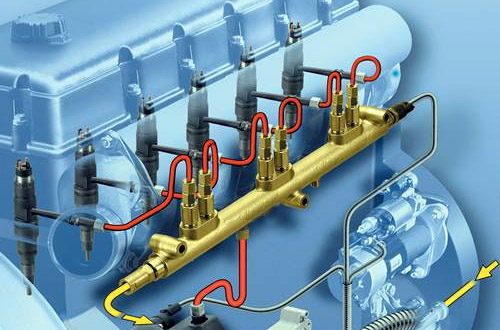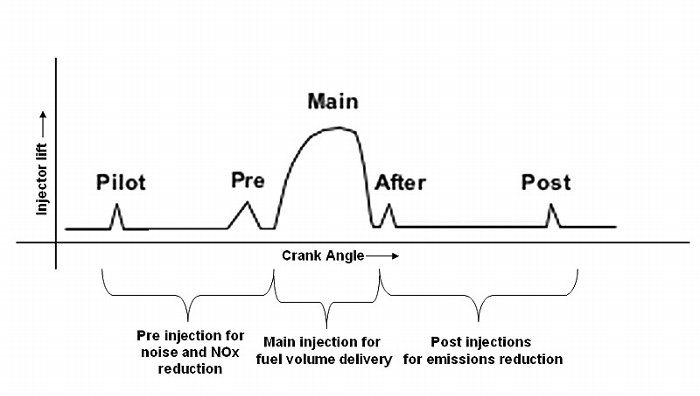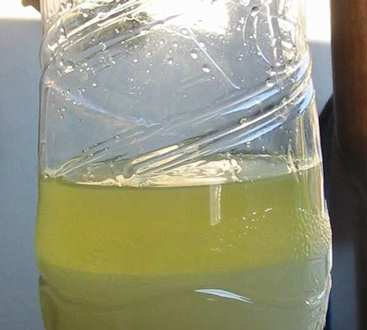

As an experienced technician, you no doubt know everything there is to know about common rail fuel injection as it applies to petrol engines, but how well do you understand common rail technology as it applies to diesel engines? To many petrol techs who have not had much, or any exposure to diesel common rail fuel systems, these systems may appear to be mystifying, confusing, and difficult to diagnose, but the truth is that there are more similarities between petrol and diesel common rail systems than there are differences, although these differences are significant.
However, while this brief overview of diesel common rail fuel systems will not turn anybody into an expert diesel technician overnight, it will serve to enable petrol technicians who have not had exposure to the technology to understand the basic principles of operation, and even to perform some basic fault finding and diagnostics. So let us start with this question-
To answer this question, we need to look at how fuel injection was accomplished before the advent of common rail technology, and what the limitations and disadvantages of previous systems were.
Historically, the two most commonly used injection systems were known as unit injection, and distributor/inline injection systems, and we are all familiar with these systems that consisted of an engine-, or belt driven injection pump that supplied each individual injector with fuel via a steel feed line. While these systems performed reasonably well in terms of both the quantity of fuel delivered and injection timing control, they suffered from severe limitations, these being the facts that-
Injection pressure was directly proportional to engine speed. In practice, this meant that the highest injection pressure could only be reached at the highest engine speed, and that injection pressure decreased as the engine speed decreased. Moreover, in these older systems, the actual injection pressure was directly linked to the instantaneous pressure of a single pumping/injection event that in turn, was linked to the design of the injector. The practical effect of this was that the relationship between engine speed and injection pressure was sometimes troublesome, if not downright problematic.
Injection was mostly limited to a single event, since the technology and control systems required to split an injection event into several pre-, and post injection events was difficult, and prohibitively expensive to produce on commercial scales.
With inline injection systems, an injection event typically starts and ends at predetermined pressures, both of which are functions of the injector design. In these injectors, also known as “dumb” injectors, the fuel pressure has to overcome the tension of an internal spring to lift the needle of its seat to allow the injection of fuel, after which the spring closes the injection port in the injector until the next injection cycle occurs.
Although distributor/inline and unit injection systems had served the automotive industry well for a hundred years or more, their inherent limitations meant that these systems could not be developed further to meet the requirements of both ever more stringent emissions regulations and consumer demands for more efficient, quieter, and cleaner diesel engines.
Taken together, these factors forced engine designers to devise an entirely new diesel fuel injection technology, which begs this question-
Put simply, engine designers settled on common rail diesel injection because it was seen to produce more power, and fewer emissions while using less fuel on petrol engines. However, since diesel engines are a) not throttled like petrol engines, and b), diesel engines always run with excess air and therefore do not require a strict stoichiometric air/fuel mixture, engine designers had to come up with innovative ways to control both the fuel pressure and volume of fuel being injected into the cylinders under all operating conditions. Let us look at some of the issues-
Like petrol engines, diesel common rail systems work on the principle that pressurised fuel is stored within a very narrow pressure margin in an accumulator (also known as the fuel rail), from where fuel is supplied to each individual injector. However, the design of the rail is critical, since it has to be able to withstand the pressure of the fuel, which can be as high as 2 000 bar (200 MPa / 29 000 psi) or more, depending on the application. More importantly though, the fuel rail has to hold a large enough quantity of fuel to prevent both a sudden drop in pressure when an injector opens, and to counteract the effects of the pressure waves that are caused by the rhythmic opening and closing of the injectors.
In practice, these fluctuating pressure waves can affect the quantity of fuel that is injected, so to alleviate these problems, the injectors on some applications hold a secondary reservoir of fuel to damp out the effects of pressure waves. One other method depends on the aspect ratio of both the fuel rail and all pressurised feed lines; by matching the required fuel flow rate to both the length and diameter of feed lines, the effects of rippling pressure waves can be reduced, if not eliminated.
Fuel pressure control can be achieved in one of two ways, these being restricting the volume of fuel that is allowed to enter the injection pump, or, by limiting the volume and pressure of the fuel that exits the injection pump.
In the first case, the actual fuel pressure in the fuel rail is monitored by a dedicated fuel pressure sensor. The ECU then compares this input data with data from other sensors, including (but not limited to) the engine speed sensor and throttle pedal position sensor to calculate the engine’s fuel requirements, which is typically expressed in litres/minute. Based on this value, the ECU will actuate a device on the injection pump that limits the volume of fuel that enters the pump. Thus, by continually comparing input data from various sensors, the ECU is able to control the fuel pressure in the fuel rail by limiting the volume of fuel that enters the injection pump. However, this method of pressure control could induce disturbances in injector dynamics if a fuel pressure regulator is mounted on the fuel rail, and/or in close proximity with the injectors.
The second method involves regulating the pressure of the fuel that leaves the injection pump with a dedicated fuel pressure regulator, which has the practical advantage that excess fuel can be added to the leakage flow from the injection pump’s pumping chamber(s), and returned to the fuel tank via the injection pump’s lubrication and cooling circuits. Note though that with both methods of fuel pressure control, an additional fuel pressure regulator may be required between the injection pump and the fuel rail on some applications.
NOTE: It should be noted that even though the injection pump is engine-driven, the effective fuel pressure is independent of both the engine speed and engine timing, regardless of the method of fuel pressure control used.
Since the fuel pressure in the fuel rail is for all practical purposes constant at a very high value, electronic control of the injectors makes it possible to break up each injection event into several “mini-injection” events, as is shown in the diagram below.

Note that while the above example shows four distinct injection events in addition to the main injection event, some modern diesel injection systems can deliver as many as seven discrete injection events in less than a millisecond.
However, while a full technical discussion of the diesel combustion process falls outside the scope of this brief overview, it is worth mentioning that by breaking up the main injection event into several smaller events, atomisation of the fuel is greatly improved. More importantly, though, the smaller injection events have the effect of “tweaking” the combustion process in such a way that the propagation of the actual detonation event is greatly improved, which in turn, greatly reduces the formation of especially NOx and hydrocarbons in the form of particulate matter (soot).
It should be noted however that the actual timing of separate injection events is dynamic, in the sense that when and how much fuel is injected during each injection event is determined by the engine speed/ load. Note also that since each injector is supplied with fuel from the fuel rail independently, the injection pressure remains constant at, or close to the rail pressure throughout the injection event.
From the above it should be obvious that injector efficiency is a critically important aspect of how well (or otherwise) a modern diesel common rail fuel injection system works.
While solenoid operated injectors have worked well for decades, the demands of Euro 5/6 emissions regulations are such that these injectors can no longer be regarded as efficient. To address these issues, many car manufacturers have adopted the use of Piezo injectors that use “stacks” of Piezo crystals (or wafers) in place of electro-mechanical components.
In short, Piezo crystals expand when an electrical current is applied to them, and contract when the current is removed. Thus, by modulating the injector pulse width, the crystals can be used as effective “valves” inside injectors to create multiple injection events within an injection cycle. In addition, since there is no friction involved, this type of injector can deliver fuel to the combustion chamber up to five times faster than even the most efficient electro-mechanical injectors can. However, due to the high power demands of Piezo injectors, manufacturers are finding new ways to make electro-mechanical injectors as efficient as Piezo injectors are.
WARNING: As tempting as it sounds to isolate a misfire on a common rail diesel engine by disconnecting Piezo injectors while the engine is running, doing this can not only result in serious personal injury or even death, since these injectors run on up to 200 volts at 15 Amps, which should make the risk of electrocution obvious. Moreover, if a Piezo injector is disconnected while it is an expanded state it loses its ground contact, which means that within only a few revolutions of the engine, enough fuel can be pumped into the engine to cause hydro locking, which as we know, usually has disastrous consequences.

While the individual components of common rail diesel injection systems are generally extremely robust and reliable, there are some causes of failures and/or malfunctions that are common to almost all applications, these being-
Incorrect, or poor quality fuel
Fuel that is contaminated with water: note that diesel engines that have not run for about 30 days will almost always have some water contamination in the fuel due to condensation
Diesel that contains a higher concentration of biodiesel than is allowed by the equipment manufacturer, regardless of the feedstock used to produce the biodiesel. Almost all biodiesels have a higher viscosity than regular diesel, which means that the “thicker” fuel may not atomise as well as it should, which can produce rough running, loss of power, and excessive emissions, among other issues
Lack of regular service and maintenance, or the introduction of dirt into the system during sloppy routine servicing/maintenance procedures. Bear in mind that the clearances in modern diesel injectors and pumps are calculated to up to four decimal places, which leaves no room for dirt or solid matter between moving parts in either injectors or injection pumps. Introduced dirt and/or contaminants will always cause damage to injection equipment
Defective fuel temperature sensor that provides the ECU with inaccurate, inconsistent, or no input data
Defective ECU; in short, this means that the fuel injection system cannot be controlled effectively
Failing to code, or integrate injectors correctly after an injector replacement
Failure of sensors that include the engine coolant sensor(s), throttle pedal position sensors, boost control sensor(s), and others. Note that the effects and/or symptoms of failed or defective sensors depends on the application, as well as the particular sensor(s) that is/are involved
Unauthorized or illegal modifications to any part, component, or system within the overall fuel management system; and particularly, modifications to the ECU’s programming. Since so-called “performance” tunes on diesel engines often produce unexpected and dramatic negative results, all diagnostic procedures on diesel common rail injection systems must start with establishing whether or not the ECU’s programming is standard- if not, the programming MUST be returned to original OEM specifications before the diagnostic process is continued
As with all fuel systems, great care MUST be exercised to avoid leaks. Apart from the fact that leaking fuel can cause an engine fire, pressurised diesel fuel that spurts from a leak at 2 000 bar can penetrate human tissue as easily as a scalpel can.
Therefore, it is critically important to always release residual pressure from the fuel system before commencing ANY work on the fuel system to avoid the possibility of sustaining serious personal injury. However, the methods of relieving residual pressure from the fuel system varies between applications, so be sure to always follow the manufacturer’s instructions exactly to avoid causing damage to yourself, and/or the fuel system.
Nonetheless, and notwithstanding any of the above, the most important safety consideration to keep in mind when working on a modern diesel common rail injection system is NEVER to remove, adjust ,disassemble, or tamper with ANY part, component, or subsystem without having a clear understanding of exactly what it is you are doing, or why you are doing it. While most faults, defects, or malfunctions in these systems can be diagnosed with high-end diagnostic equipment, actually finding and repairing the defect requires skills, equipment, and facilities that are generally not available in petrol-oriented workshops.